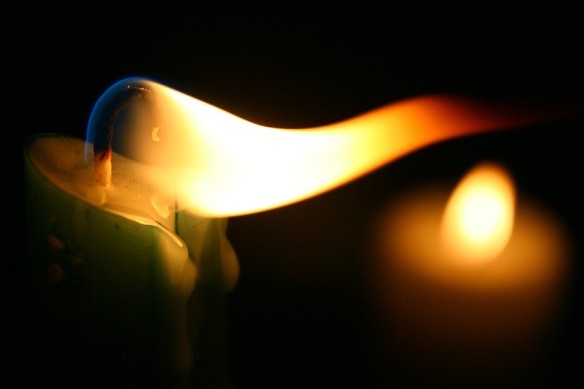Tag Archives: christmas fire
Avoid Holiday Fire Disasters Through Safe Candle Use
Candles lend a special light to the holiday season: Halloween jack-o-lanterns, Thanksgiving dinner tables, Advent wreaths, Menorahs, luminarias, and Kwaanza Kinaras. If not for a seasonal purpose, then perhaps the romantic lighting or the smell of sugar cookies has convinced you that candles are an undeniable asset to ambiance. Whatever the reason, candle safety is important, particularly during the holiday season when their use is particularly common. Here are some basic guidelines to help keep you safe. Commit these to memory and avoid the embarrassment of last year’s flaming cheese fondu (the result of a single candle… and might I add, not my fault).
Who
Children should be taught to stay away from lit candles. Try to keep them out of reach of young children and pets. Candle lighting is not an appropriate activity for small children, so keep matches and lighters out of the sight and reach of children.
Where
Burn candles away from drafts, other heat sources, and all flammable objects or materials. In other words, never use candles near windows or exits. Don’t place them on Christmas trees, real or artificial (I know, it’s tradition, but setting the house on fire isn’t). Keep burning candles away from curtains, wrapping paper, paper, combustible decorations and displays (including Aunt Juanita’s hair), flammable liquids, and aerosol sprays (please see Aunt Juanita’s hair), such as hair spray, which can explode. Never allow a candle flame to touch any glass surface.
When
Don’t burn candles for more than four hours at a time. Unattended candles are an invitation to disaster, so don’t forget to snuff out candles before leaving the room or going to bed (that’s right, falling asleep to candle light: bad idea). Blowing out candles doesn’t do the trick: extinguish them by wetting the wick.
And some other quick tips:
- Candles other than jar candles must be used in an appropriate non-tipping, non-flammable holder made of tempered glass or made with a proper glaze.
- Place candles on a safe, heat-resistant dry surface. If possible, place glass chimneys or shades over them.
- For Christmas luminarias, use 15-hour votive candles in holders placed in paper bags filled with at least 2 inches of sand. The candle must be of a size that will allow adequate space between the candle and bag so as not to ignite the bag.
- Remove labels and tags from candles before burning.
- Keep wicks trimmed to 1/4 inch at all times. This inhibits smoking and carbon build-up at the tip of the wicks and provides a cleaner burn.
- Sometimes a layer of liquid wax forms that causes the wick to fall to the side. To maintain an even burn, keep the wick centered. This will also protect the candle holder, since a flame that’s too close for too long may crack the holder.
- Keep the wax pool free of foreign objects such as wick trimmings and matches. They will interfere with proper burning and are flammable.
- Extinguish taper or pillar candles when they get within 2 inches of their holders. Discontinue use of candle containers when 1/2″ of wax remains.
Sandy Hayden
Content Credit: http://www.tdi.texas.gov/pubs/sfmo/fmcandlesafe.pdf
Photo Credit: http://4.bp.blogspot.com/-Gr7XtAzEu4k/Tf_6YP3OCuI/AAAAAAAAG70/8oopQrez4Ic/s1600/candle_flame.jpg
Choosing a Tree
The difference between the most wonderful time of the year and a call to SERVPRO can be in the choosing of this year’s tree. Christmas trees are involved in approximately 400 fires annually, according to the National Fire Protection Association. These typically result in more than a dozen deaths, dozens of injuries, and more than $10 million in property loss and damage. In short: circuiting tree lights are cited as the leading cause.
 Since the holiday season has begun, take a few of safety tips courtesy of the State Fire Marshal’s Office on choosing and preparing Christmas trees for decoration that will minimize the risk of fire and injuries.
Since the holiday season has begun, take a few of safety tips courtesy of the State Fire Marshal’s Office on choosing and preparing Christmas trees for decoration that will minimize the risk of fire and injuries.
- If you’re buying an artificial tree, it should bear the “Fire Resistant” label. While this type of tree can catch fire, it will resist burning and should extinguish quickly.
- If you’re buying a natural tree, buy the freshest you can find. A fresh tree is green, needles are hard to pull from branches and when bent between your fingers, needles do not break. The trunk butt is sticky with resin, and when tapped on the ground, the tree should not lose many needles.
- Watch out for trees with a greenish cast to their trunks and branches; many growers spray trees with green paint to make them look more appealing.
- Cut at least one inch off the trunk’s base to expose fresh wood for better water absorption. A tree will absorb as much as a gallon of water or more in the first 24 hours and one or more quarts a day thereafter. A seal of dried sap will form over the cut stump in four to six hours if water drops below the base of the tree, preventing the tree from absorbing water later when the tree stand is refilled. If a seal does form, another fresh cut will need to be made.
- To maximize freshness and minimize fire risk, keep the tree outdoors for a few days in a bucket filled with water before bringing it indoors to decorate. The tree stand should hold at least one gallon of water.
- Because heated rooms dry out natural trees rapidly, keep the stand filled with water; check the water level daily. A six-foot tree will absorb one gallon of water every two days.
Sandy Hayden
Content Credit: http://www.tdi.texas.gov/pubs/sfmo/fmchoosetree.pdf
Photo Credit: http://favim.com/orig/201108/26/christmas-tree-photography-snow-tree-weather-Favim.com-130939.jpg




